Preview for our 3rd Auction from 3.-4. of March 2017
Philatelic items – especially those of the classic or semi-classic period – which qualify for a philatelic „Champions League“ by their extremely fine conditon (e.g. fresh colours, broad margins or SON cancels) or by their pure rareness are not listed in the „Michel“ or in any other stamp catalogue.
In our upcoming auction we are able to offer a handful of such „philatelic birds of paradise“.
We are talking of the British and French Occupation issues for the German Colonies shortly after the outbreak of WW1 in 1914-1915.
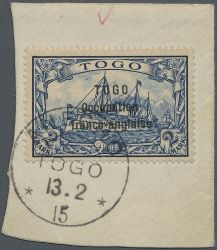
The all-time highlight among a half dozen of high calibre items is the „2 Mark“ value – seen already on our front page - of the French Occupation issues for the colony of Togo. It comes on an unbeatable piece with a clear „Anecho“ cancellation. Only 7 (seven!) stamps were overprinted and sometimes it lasts for decades until such a stamp is offered on the philatelic market.(Just for the record: Her both big sisters, the „3 Mark“ and the „5 Mark“ value were auctioned in a rarity sale on the occasion of the world exhibition London 2015 and the happy buyer had to pay more than 250.000 Euros, this being 2 ½ time of their catalogue value..)Our „2 Mark“ is offered at a starting price of 20.000 Euro; however it will be most probably knocked down in another dimension.
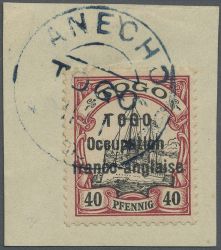
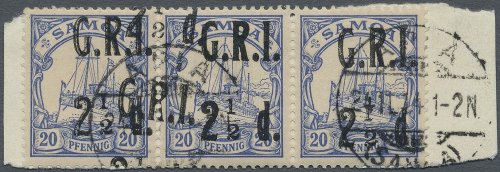
There is also a 40 Pfenning value – of the same series – on offer in this sale. Of this stamp (Mi.No. 14) 36 pieces were printed and again it has to be ascertained that this tiny number does not apply to the definition of „bulk goods“! The most crazy item is a horizontal strip of three of the „2 ½ G.R.I.“ overprint value of the British Occupation of Samoa: the two left hand stamps show a clear double overprint and according to Gibbs these are the only double overprints showing the „no fraction“ variety.
"Minister Bötticher with ear"
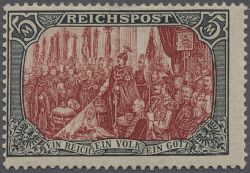
How many items in good condition may still exist of this famous „Zwischentype“ of the German Reich (Michel No. 66 Z)? It can`t be many. The piece on offer comes with a new certificate of the expert in charge, stating „an above average quality example of this extremely scarce stamp“. This is a true gem which would highlight any Germany collection. (Estimate 18.000 Euros).
Let us focus a bit on the German States....
There are some quite remarkable covers among which the depicted item of Brunswick stands as an example:
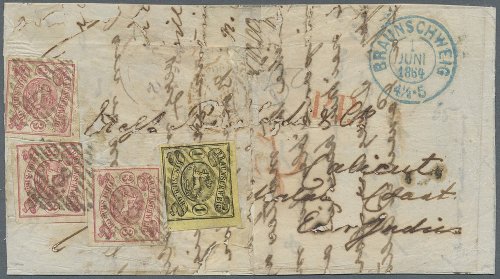
Three by three plus one – this makes 10 Silbergroschen altogether serving as franking on a letter from BRAUNSCHWEIG to Calicut at the coast of Malabar. This destination „India“ is most probably unique for a franked cover of Brunswick – in any case we did not find a comparable item in the literature we have in hand. It is estimated at 5000 Euro (which, of course, leaves some phantasy for bidding...) and this „full of character“ item could get you the missing 1-2 points for your gold medal collection even taking into consideration that the outer cover shows its age in places.
A little-known rarity of Hamburg – the „Michel No. 12 I“
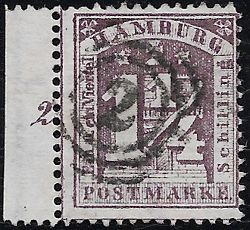
Among all postage stamps of Hamburg, which were issued between 1859 and 1867, the „1 ¼ Schilling“ denomination has a special importance.
The postal service between the Free and Hanseatic City of Hamburg and the Duchies of Slesvig and Holstein was handled by the Royal Danish Post Office at Hamburg. The Duchies belonged to Denmark at that time.
But this changed virtually overnight when Denmark lost the Prussian-Danish war of 1864 and had to retreat.
The Royal Danish Post Office of Hamburg („K.D.O.P.A.“) was shut down consequently on Feb 20, 1864 and the town post office of Hamburg („Stadtpostamt“) took over.
For all letters to the Duchies or further up north to Denmark stamps of the denomination of „1 1/4“ and „2 1/2“ Schilling were urgently needed. The fastest way to meet the demand was the production of stamps by lithographic print. This was executed by the Adler print office at Hamburg. Both values – listed in the Michel catalogue as Nos. 8 and 9 – were already available at the post office by the end of February 1864, only eight days (!) after the postal service had had to be organised by the town post office.
In the year of 1864 Hamburg introduced – as many other states – the perforation of stamps as a more practical means to separate single stamps from the sheet, allowing also to sell individual pieces to the public. (In the times before, the imperforate stamps were sold only in „rows“ (of ten) which led to low sales figures especially of the more uncommon denominations.)
The „1 ¼ Schilling“ value was much in demand and letters with this franking today are the most common ones besides local letters. For the print of the perforated stamps new printing stones had to be made as the first litho stones were soon worn out.
Only a small number of the imperforate sheets – which were all made from the first stone – were perforated afterwards. These stamps are listed in the Michel catalogue as „No. 12 I (1.Druckstein)“. Only 96.000 copies were produced of this stamp while her sister („Michel No. 12 II, 2.Druckstein“) which was made from the second stone comes up to a printing number of nearly 1,1 million copies.
For the keen collector both stamps are easily to distinguish, however, in many collections the cheap one (Michel No. 12 II) is sitting as a spacefiller for the much better one.
In our upcoming auction of March 3-4, 2017 we are able to offer a very special example of this stamp, being a copy from the left sheet margin. The margins all bear numbers (for the rows), this one shows the No. „2“ row number and comes in perfect condition, fine used. Stamps with adherent sheet margins are extremely scarce – in all conditions be it unused or used. None of the most important Hamburg collections which were sold over the last 30 years (such as Boker, Kuphal, Sellschopp) contained a comparable item.
This is a true opportunity to aquire a unique copy of „Hamburg“ philately.
All other rarities of the collecting area of „Hamburg“ are also included in the offer which comprises around 100+ lots.
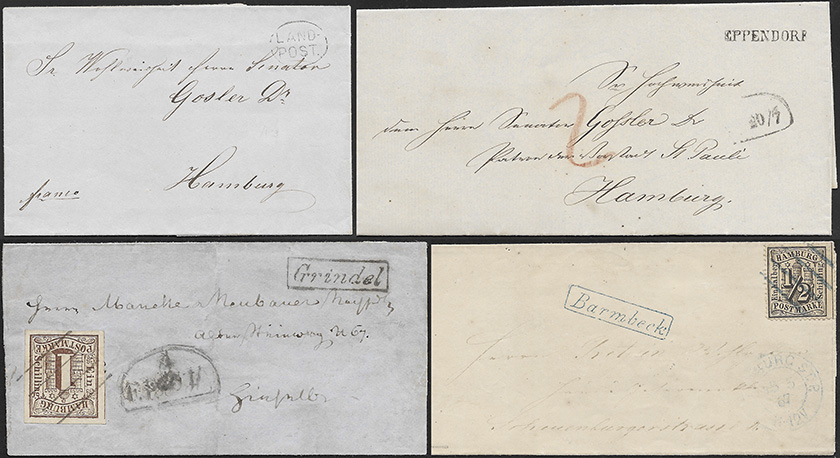
A special section deals with the rural cancellations (former suburbs of Hamburg). There are only four letters known bearing the oval LAND-POST cancellation, equally scarce is the EPPENDORF straighline cancellation of the pre-philatelic era. But also the later cancellations of the suburbs of „Barmbeck“, „Eimsbüttel“ or „Grindel“ - just to name a few – are available in pristine condition.
Europe and overseas areas - a short survey
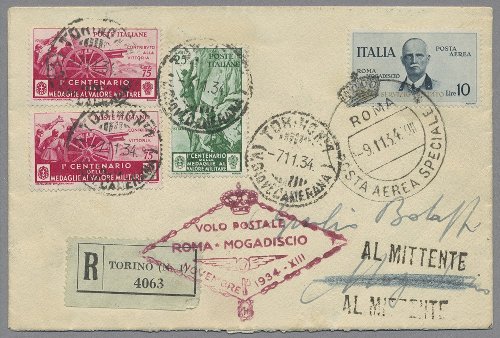
The Italian service stamp 10 Lire overprinted, the so-called „coroncina“ was only valid for the Rom to Mogadischu special flight in 1934. Consequently this stamp is very scarce in used condition. But have a look on the perfect centering of this example. A conoisseur knows about the scarcity of pieces with good centering and that is the reason why the Italian Sassone catalogue grants a 50% premium on the normal quotation for well centered stamps of this issue. A Sorani photo certificate accompanies..
"Forgeries more expansiv than originals!"
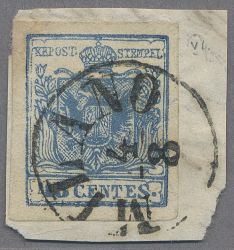
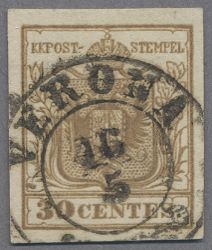
These two stamps are valuable because they are forged. The first one was produced in 1853 in the city of Verona, the other one in 1857 in Milan.
Both postal forgeries belong to an extended offer of classic Austrian material comprising about 150 lots in total. Just to quicken your appetite, here are some examples:
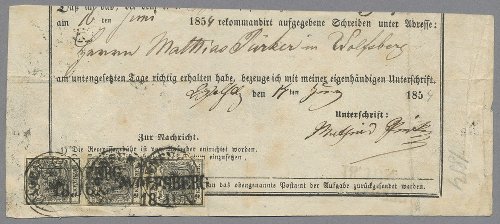
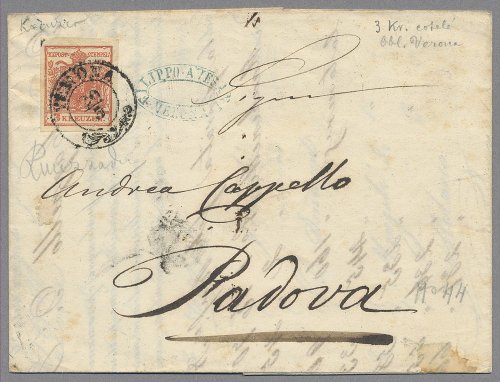
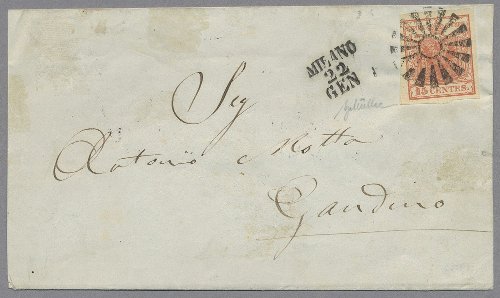
"Tricky franking"
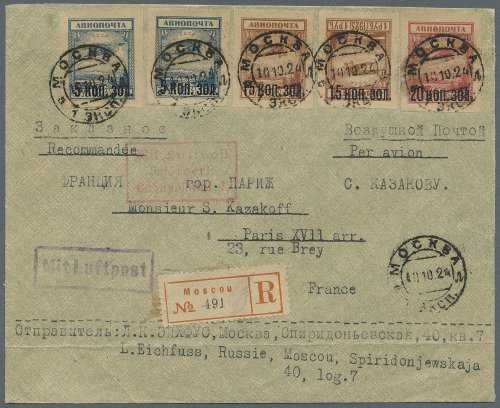
The Russian air mail stamp with the 15 Kop denomination overprint of 1924 might not catch your eye at the first glance. However, the sender was fully aware why he placed that stamp upside down on the cover. The reason was that the very straight control office for the exchange of collectors` items („Tauschkontrolle“) might have discovered that the stamp bears an inverted overprint. By franking this variety like a normal one, the letter went through censorship without complications and arrived safely its destination. These air mail stamps with inverted overprints are big rarities and are not listed on cover – not even in Russian specialised catalogues.
Finally "Zeppelins"
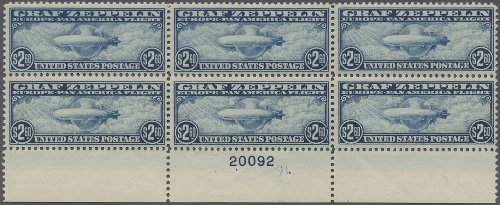
Collecting „plate blocks“ is very popular not only in the United States. However, if it comes to the most valuable issue of the 1930ies we are talking about veritable rarities. Only about 1200 sheets of the top value 2.60 Dollars were printed and each sheet contains only one plate block. Again you may put our question of likelihood on the agenda: How many „plate blocks“ of this issue may have survived?
In total there will be about 3700 lots and collections adding up to a total estimate of approximately 1,2 Million Euro. The complete catalogue will be online on February 2, 2017. The print version will be on its way from February 2, 2017 on.